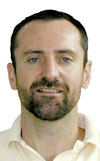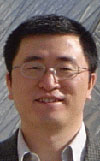Invited Talks November 2006
Invited Talk by Prof. Gabor Fichtinger, PhD

|
Prof. Gabor Fichtinger, PhD
(Engineering Research Center for Computer-Integrated Surgical Systems and Technologies, Johns Hopkins University, Baltimore, MD, USA) will be giving an invited talk on Tuesday, Nov. 14, 13:00-14:30, in room MI 00.13.009A
on
"Toward Affordable High Tech Medicine - Image-Guided Percutaneous Interventions"
|
This talk is open to everyone interested in the topic.
Abstract:
Image-guided percutaneous (i.e. through the skin) needle based interventions, such as biopsies, aspirations, injections, tissue ablations, and radioactive implants represent a dynamically growing segment of our healthcare today. These procedures, if performed under precise computational image guidance, promise therapeutic outcomes similar to conventional surgery, but with a significantly reduced rate of complications and morbidity, and ultimately, at a lower cost. Minimally invasive surgical techniques are currently undergoing a revolutionary technological improvement in the leading medical institutions in North America and Europe. The unprecedented rapid change of the technology base is accurately reflected by the shrinking average lifespan of medical imaging devices that are used in the planning and delivery of these procedures. New imaging devices that offer higher patient throughput and better image quality are quickly replacing older but still functional devices. While this has been an overarching theme in recent research, developers should also attend to the needs and limited means of underprivileged societies. The talk will present such novel computer-integrated surgical systems that concentrate on providing high tech medicine for average care facilities, without imposing significant changes on their current clinical infrastructure and procedural workflow.
These clinically feasible solutions tend to depend on advanced image processing and modeling techniques, while they require only simple auxiliary instrumentation. The talk will sample specific research projects currently in progress at the Johns Hopkins University and its collaborators.
Biography:
Gabor Fichtinger received BS and MS in Electrical Engineering, and Doctorate in Computer Science from the Technical University of Budapest, Hungary, in 1986, 1988, and 1990, respectively. He received postdoctoral training at the University of Texas at Austin between 1990-1992 in high performance computing and biomedical visualization. In 1993, he joined the George Washington University Hospital where he architected stereotactic radiosurgery and computer-assisted neurosurgical systems. Before joining the Johns Hopkins University in 1999, he also worked in the medical device industry, developing computer-assisted radiation therapy planning systems.
Dr. Fichtinger focuses his current research on computer-integrated surgery. He leads a major research thrust dedicated to image-guided needle placement procedures, with a strong focus on interventional oncology, a subject in which he has authored and co-authored over 100 peer-reviewed manuscripts. Professor Fichtinger is the Engineering Director of the Center for Computer Integrated Surgical Systems and Technologies, and he holds the rank of Associate Research Professor in Computer Science, Mechanical Engineering, and Radiology. He serves on the Board of Directors of the Medical Image Computing and Computer Assisted Interventions
(MICCAI) Society and has been a scientific reviewer for many journals, publishers, and research funding agencies, both in the U.S. and internationally.
Invited Talk by Chenyang Xu, PhD

|
Chenyang Xu, PhD
(Siemens Corporate Research, Princeton, NY, USA) will be giving an invited talk on Monday, Nov. 13, 9:00-10:00, at Klinikum Innenstadt, Chirurgie, Direktionstrakt, Bibliothek (room no. 103)
on
"Interventional Imaging Program at Siemens Corporate Research"
and on
"Medical Image Segmentation Using a Topology-preserving Geometric Deformable Model"
|
Directions:
Chirurgische Klinik, Nußbaumstr. 20
Once inside the building, go to the 1st floor into the aisle called "Direktionstrakt" an look for one of the last rooms, the Bibliothek.
You may also meet us at 8:45 at Pettenkoferstr. 8a - at the front entrance of the of "Poliklinik".
Abstract:
This talk consists of two parts. In the first part of the talk, I will introduce the interventional imaging program at Siemens Corporate Research, formed in 2002 to address the increasing clinical needs from many interventional procedures for customized image processing & computer vision techniques. I will provide both an overview of selected R&D activities and a specific example in the area of image-guided electrophysiology to illustrate how we develop customized image processing & computer vision technology that is now part of a successful clinical product used routinely in hospitals worldwide.
In the second part of the talk, I will present a novel geometric deformable model for medical image segmentation that preserves topology
during its deformation. Standard geometric deformable models,
implemented via level set methods, have advantages over parametric models due to their intrinsic behavior, parameterization independence, topological flexibility, lack of self-intersections, and good numerical stability. However, in medical applications where the final segmented model must conform to the known topology of the anatomical object(s), topological flexibility can actually hinder the application of geometric deformable models. In these applications, one would prefer topology preserving deformation rather than topology changing deformation. The proposed topology-preserving geometric deformable model addresses this long standing limitation. It not only conforms to the topology constraint but also maintains other desirable characteristics of standard geometric deformable models including both sub-pixel accuracy and production of non-intersecting curves (or surfaces). I will demonstrate its performance in the application of human brain cortex reconstruction from magnetic resonance (MR) images.

